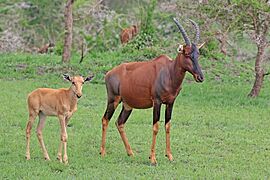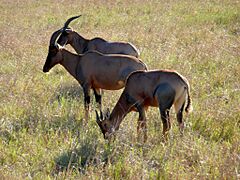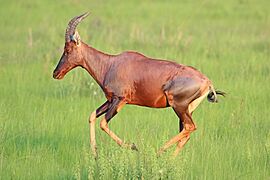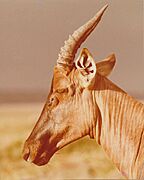Topi facts for kids
Quick facts for kids Topi |
|
|---|---|
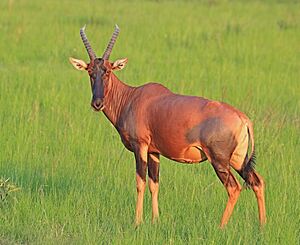 |
|
| Queen Elizabeth National Park, Uganda | |
| Conservation status | |
| Scientific classification |
|
| Kingdom: | Animalia |
| Phylum: | Chordata |
| Class: | Mammalia |
| Order: | Artiodactyla |
| Family: | Bovidae |
| Subfamily: | Alcelaphinae |
| Genus: | Damaliscus |
| Species: | |
| Subspecies: |
D. l. jimela
|
| Trinomial name | |
| Damaliscus lunatus jimela (Matschie, 1892)
|
|
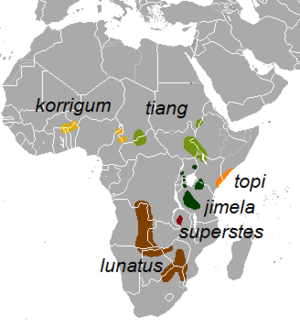 |
|
| Range in dark green | |
| Synonyms | |
|
|
The topi (scientific name: Damaliscus lunatus jimela) is a type of antelope. It is known for being very social and fast. Topis live in the savannas, semi-deserts, and floodplains of sub-Saharan Africa. They are a subspecies of the larger topi species, Damaliscus lunatus.
Contents
What's in a Name?
The name topi comes from the Swahili language. It was first written down in the 1880s by a German explorer named Gustav Fischer. He used it to describe the topi he saw in Kenya.
Other names were also used in East Africa. For example, in the Nyamwezi language, they were called jimäla. By the early 1900s, most English speakers called this antelope a topi.
Where Topis Live and Their Family Tree
The topi, Damaliscus lunatus jimela, was first described in 1892. A German zoologist named Paul Matschie used a skull and a painting to identify it. Topis are found in several African countries. These include the Democratic Republic of the Congo, Kenya, Rwanda, Tanzania, and Uganda. Sadly, they are no longer found in Burundi.
Scientists sometimes group topis differently. Some think there are three different species. Others believe they are all part of the same larger topi species, Damaliscus lunatus korrigum.
What Topis Look Like
Topis have a unique look. Their fur color can be different depending on where they live. Some are darker, while others are lighter.
Their horns have a special shape. When you look at them from certain angles, the space between them looks like a lyre (a musical instrument). This is different from other related antelopes whose horns might look more like a crescent moon.
-
Female topi with her calf in Uganda
-
A topi in the Serengeti
-
Topi grazing in the Masai Mara
-
A topi running in Uganda
Topi Life and Habits
Topis like to eat green grass that is not too tall. They are often found in areas where green plants stay longer, especially near water. When they eat, they take small, quick bites.
Topis have very interesting social lives. They can live in different types of groups. Some males defend a specific area (territory) and have a group of females living with them. These groups usually stay together.
Most topi babies are born between October and December. Female topis might stay in the same territory for up to three years. The male topi and his females work together to protect their territory.
Topi Status and Conservation
In 2008, the topi was listed as "least concern" by the IUCN. This meant they were not in immediate danger of extinction. At that time, there were about 93,000 topis, with most of them living in protected areas. However, experts believed their numbers were slowly going down.
Topi Populations in Different Countries
- Tanzania: In 1998, there were about 58,510 topis. By 2014, this number had dropped to between 35,000 and 46,500. Most of these live in the Serengeti.
- Kenya: In the late 1970s, there were many topis, around 126,330. By 1998, the number was estimated at 11,120, though other counts showed more. A study in 2011 found that the topi population in and around Masai Mara National Park had dropped by over 70% since the late 1970s.
- Rwanda: In 1998, there were fewer than 500 topis. By 2015, counts showed about 805 topis in Akagera National Park. This increase was likely because there were fewer predators.
- Uganda: In the 1970s, there were thousands of topis in areas like Queen Elizabeth National Park. However, their numbers dropped significantly by the early 1980s. This was due to poaching, lions eating them, and changes in their habitat. The land was becoming more like a forest, with trees growing where grasslands used to be. Recent surveys show fluctuating numbers, with about 2,679 topis counted in 2014 in the Lake Edward region.
Some areas in Uganda, like Pian-Upe Game Reserve, might have lost all their topis. There are plans to move topis to these areas to help them return.
In Lake Mburo National Park, topi numbers have also changed. The park's grasslands are turning into bushland because of an invasive plant called Acacia hockii. This forces topis into nearby farms, where they are sometimes seen as pests. Efforts are being made to manage the habitat and help the topi population.
In 2016, the IUCN estimated there were 50,000-70,000 adult topis. They continued to say the population was decreasing. The decline in Tanzania, where most topis live, suggests the global population might have dropped by about 36%. This could mean they are becoming "vulnerable," which is a higher risk category.
Related pages
- Damaliscus lunatus, a large African antelope of the genus Damaliscus commonly known as Topi




